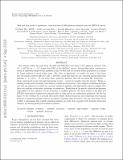Fast and slow paths to quiescence : ages and sizes of 400 quiescent galaxies from the LEGA-C survey
Abstract
We analyze stellar age indicators (Dn4000 and EW(Hδ)) and sizes of 467 quiescent galaxies with M∗≥1010M⊙ at z∼0.7 drawn from DR2 of the LEGA-C survey. Interpreting index variations in terms of equivalent single stellar population age, we find that the median stellar population is younger for larger galaxies at fixed stellar mass. The effect is significant, yet small; the ages of the larger and the smaller subsets differ by only<500 Myr, much less than the age variation among individual galaxies (∼1.5 Gyr). At the same time, quiescent galaxies with the strongest Hδ absorption —those experienced recent and rapid quenching events — tend to be smaller than the average. These co-existing trends unify seemingly contradictory results in the literature; the complex correlations between size and age indicators revealed by our large sample of galaxies with high-quality spectra suggest that there are multiple evolutionary pathways to quiescence. Regardless of the specific physical mechanisms responsible for the cessation of star formation in massive galaxies, the large scatter in Dn4000 and EW(Hδ) immediately implies that galaxies follow a large variety in evolutionary pathways. On the one hand, we see evidence for a process that slowly shuts off star-formation and transforms star-forming galaxies to quiescent galaxies without necessarily changing their structures. On the other hand, there is likely a mechanism that rapidly quenches galaxies, an event that coincides with dramatic structural changes, producing small post-starburst galaxies.
Citation
Wu , P-F , van der Wel , A , Bezanson , R , Gallazzi , A , Pacifici , C , Straatman , C M S , Barišić , I , Bell , E F , Chauke , P , van Houdt , J , Franx , M , Muzzin , A , Sobral , D & Wild , V 2018 , ' Fast and slow paths to quiescence : ages and sizes of 400 quiescent galaxies from the LEGA-C survey ' , Astrophysical Journal , vol. 868 , no. 1 , 37 . https://doi.org/10.3847/1538-4357/aae822
Publication
Astrophysical Journal
Status
Peer reviewed
ISSN
0004-637XType
Journal article
Description
Funding: VW acknowledges funding from the ERC (starting grant SEDmorph, PI. Wild)Collections
Items in the St Andrews Research Repository are protected by copyright, with all rights reserved, unless otherwise indicated.
Related items
Showing items related by title, author, creator and subject.
-
SDSS-IV MaNGA: How the stellar populations of passive central galaxies depend on stellar and halo mass
Oyarzún, Grecco A.; Bundy, Kevin; Westfall, Kyle B.; Tinker, Jeremy L.; Belfiore, Francesco; Argudo-Fernández, Maria; Zheng, Zheng; Conroy, Charlie; Masters, Karen L.; Wake, David; Law, David R.; McDermid, Richard M.; Aragón-Salamanca, Alfonso; Parikh, Taniya; Yan, Renbin; Bershady, Matthew; Sánchez, Sebastián F.; Andrews, Brett H.; Fernández-Trincado, José G.; Lane, Richard R.; Bizyaev, D.; Boardman, Nicholas Fraser; Lacerna, Ivan; Brownstein, J. R.; Drory, Niv; Zhang, Kai (2022-07-06) - Journal articleWe analyze spatially resolved and co-added SDSS-IV MaNGA spectra with signal-to-noise ratio ∼100 from 2200 passive central galaxies (z ∼ 0.05) to understand how central galaxy assembly depends on stellar mass (M*) and halo ... -
Secular-and merger-built bulges in barred galaxies
Mendez Abreu, Jairo; Debattista, V. P.; Corsini, E. M.; Aguerri, J. A. L. (2014-12) - Journal articleContext. Historically, galaxy bulges were thought to be single-component objects at the center of galaxies. However, this picture is now questioned since different bulge types with different formation paths, namely classical ... -
Galaxy And Mass Assembly (GAMA) : galaxy close pairs, mergers and the future fate of stellar mass
Robotham, A. S. G.; Driver, S. P.; Davies, L. J. M.; Hopkins, A. M.; Baldry, I. K.; Agius, N. K.; Bauer, A. E.; Bland-Hawthorn, J.; Brough, S.; Brown, M. J. I.; Cluver, M.; De Propris, R.; Drinkwater, M. J.; Holwerda, B. W.; Kelvin, L. S.; Lara-Lopez, M. A.; Liske, J.; Lopez-Sanchez, A. R.; Loveday, J.; Mahajan, S.; McNaught-Roberts, T.; Moffett, A.; Norberg, P.; Obreschkow, D.; Owers, M. S.; Penny, S. J.; Pimbblet, K.; Prescott, M.; Taylor, E. N.; van Kampen, E.; Wilkins, S. M. (2014-11-11) - Journal articleWe use a highly complete subset of the Galaxy And Mass Assembly II (GAMA-II) redshift sample to fully describe the stellar mass dependence of close pairs and mergers between 10(8) and 10(12)M(circle dot). Using the analytic ...

